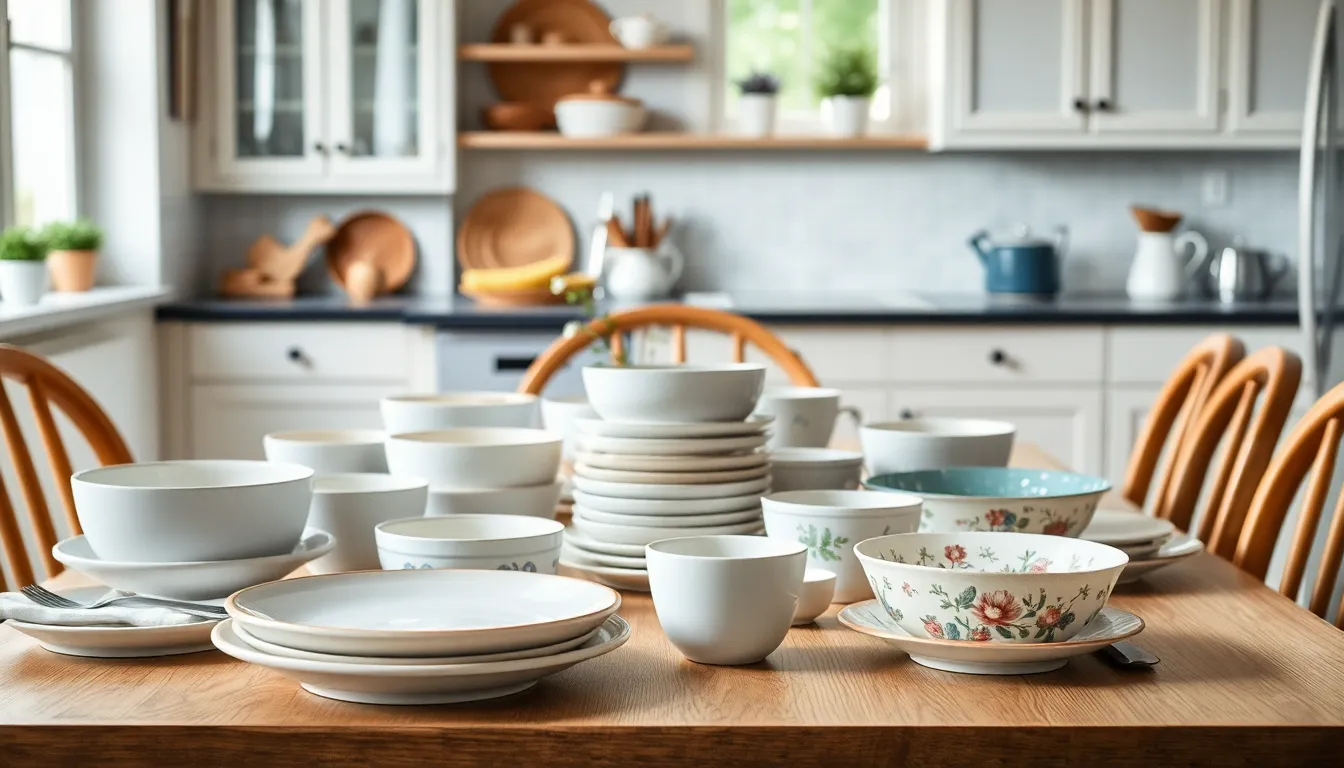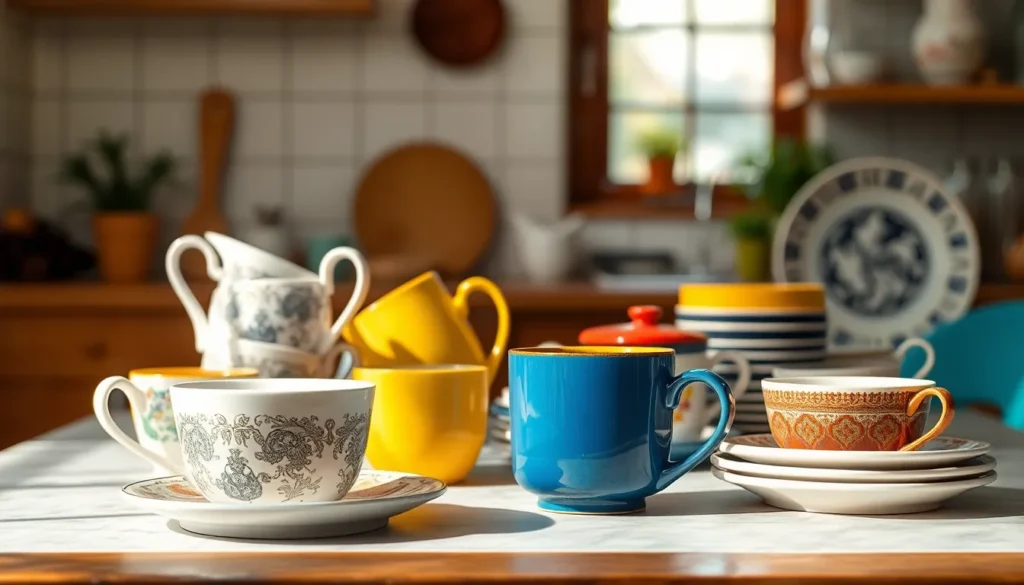Ceramic homeware isn’t just about functionality; it’s a way to elevate everyday living. Imagine sipping your morning coffee from a beautifully crafted mug that feels as good as it looks. It’s like giving your kitchen a stylish makeover without the hefty price tag. Whether it’s dinner plates that make your meals look like art or quirky bowls that spark joy, ceramic pieces bring personality to any home.
Table of Contents
ToggleOverview of Ceramic Homeware
Ceramic homeware blends functionality with aesthetic appeal, enhancing the daily dining experience. Various items, from tableware to decorative pieces, showcase the versatility of ceramics in any household.
Definition and Types
Ceramic homeware refers to items made from molded and fired clay, offering durability. Common types include dishware like plates and bowls, cookware like baking dishes, and decorative items such as vases and figurines. Each type exhibits unique properties, making ceramics suitable for various applications. Stoneware, earthenware, and porcelain represent the major ceramic categories, with each type providing distinct characteristics.
Benefits of Using Ceramic Homeware
Using ceramic homeware provides numerous advantages, starting with its durability. Ceramics resist chipping and scratching, ensuring longevity in everyday use. The non-porous nature of ceramics prevents absorption of food odors and stains, promoting easy cleaning. Additionally, ceramics can handle high temperatures, making them safe for oven and microwave use. Their aesthetic appeal adds a stylish touch to kitchen and dining decor, enhancing the overall home atmosphere while remaining affordable.
Popular Designs and Styles

Ceramic homeware features a variety of designs and styles that appeal to diverse tastes. These options enhance both aesthetic appeal and functionality.
Modern vs. Traditional Designs
Modern designs often highlight sleek lines and minimalist forms. They suit contemporary kitchens and lend a fresh look to dining spaces. Traditional designs, on the other hand, embrace intricate patterns and vintage aesthetics. Floral motifs, hand-painted details, and classic color schemes characterize this style. Each design type reflects personal preferences, allowing individuals to choose items that harmonize with their home decor.
Color and Finish Options
Ceramic homeware presents an array of color and finish options. Bright, vibrant hues energize dining tables, adding a playful element to mealtime. Soft pastels evoke a calm, soothing atmosphere. Glossy finishes create a polished look, enhancing the colors, while matte textures offer a more understated appeal. These choices enable consumers to mix and match pieces, ensuring a cohesive yet dynamic dining experience.
Care and Maintenance of Ceramic Homeware
Caring for ceramic homeware ensures longevity and preservation of its beauty. Proper cleaning and storage techniques contribute to maintaining these items in excellent condition.
Cleaning Tips
Cleaning ceramic homeware requires gentle methods to avoid damage. Use warm soapy water for routine washing, as harsh chemicals can dull the surface. A soft sponge or cloth works well, while abrasive scrubbers may cause scratches. Stains can often be removed with a paste of baking soda and water. For items with decorative elements, check for specific care instructions, as some glazes can be sensitive to extreme temperatures. Never place ceramic pieces under direct heat or in the microwave unless labeled as microwave safe.
Storage Recommendations
Storing ceramic homeware demands careful consideration to prevent chips and breaks. Nesting plates and bowls isn’t recommended, as this can lead to unintended contact and damage. Instead, stack items with protective padding, such as cloth or paper towels, between them. Display pieces should be kept in secure locations, away from high-traffic areas. For larger items, consider using a cabinet with shelves designed for easy access and visibility while providing protection. Additionally, maintain a stable temperature in storage spaces to avoid cracking due to thermal shock.
Sustainability and Environmental Impact
Ceramic homeware offers numerous sustainable benefits that resonate with environmentally conscious consumers. It consists primarily of natural materials, primarily clay and minerals. These components do not release harmful chemicals during production or use. Furthermore, ceramic pieces are long-lasting, reducing the need for frequent replacements and minimizing waste.
Eco-Friendly Aspects of Ceramic
Ceramic homeware exhibits strong eco-friendly characteristics. First, its recyclability contributes to reduced environmental impact. Second, production often uses lower energy compared to plastics and metals. Many ceramic manufacturers implement sustainable practices, including utilizing local clay sources and eco-conscious firing methods. Natural glazes mean fewer toxic substances, ensuring safer usage around food and beverages. The durability of ceramic extends its lifecycle, allowing items to serve users reliably for years.
Comparison with Other Materials
When comparing ceramic homeware to other materials, ceramics excel in sustainability. Glass, while recyclable, requires high energy to produce. Plastic items often degrade, releasing toxic substances that contribute to pollution. Metal cookware can require significant mining and energy-intensive processing. In contrast, ceramics offer durability without the environmental cost associated with many alternatives. Despite being heavier, ceramic’s lifespan offsets this drawback by promoting longevity in homeware usage. Additionally, ceramic designs often embrace timeless aesthetics, ensuring they stay relevant as trends shift.
Ceramic homeware stands out as a perfect blend of style and practicality. Its durability and aesthetic appeal make it an ideal choice for anyone looking to elevate their dining experience. With a variety of designs and colors available, individuals can easily find pieces that reflect their unique tastes and enhance their home decor.
Moreover, the sustainability of ceramic homeware aligns with the growing demand for eco-friendly products. By choosing ceramic, consumers not only invest in long-lasting items but also contribute to a healthier planet. The thoughtful care and maintenance tips shared ensure that these beautiful pieces remain cherished for years to come. Embracing ceramic homeware means embracing a lifestyle that values both beauty and functionality.






